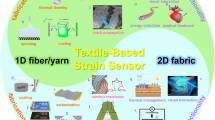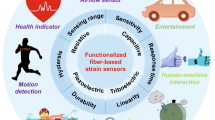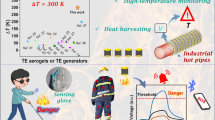Abstract
This paper presents design, fabrication and testing of a quad beam silicon piezoresistive Z-axis accelerometer with very low cross-axis sensitivity. The accelerometer device proposed in the present work consists of a thick proof mass supported by four thin beams (also called as flexures) that are connected to an outer supporting rim. Cross-axis sensitivity in piezoresistive accelerometers is an important issue particularly for high performance applications. In the present study, low cross-axis sensitivity is achieved by improving the device stability by placing the four flexures in line with the proof mass edges. Various modules of a finite element method based software called CoventorWare™ was used for design optimization. Based on the simulation results, a flexure thickness of 30 μm and a diffused resistor doping concentration of 5 × 1018 atoms/cm3 were fixed to achieve a high prime-axis sensitivity of 122 μV/Vg, low cross-axis sensitivity of 27 ppm and a relatively higher bandwidth of 2.89 kHz. The designed accelerometer was realized by a complementary metal oxide semiconductor compatible bulk micromachining process using a dual doped tetra methyl ammonium hydroxide etching solution. The fabricated accelerometer devices were tested up to 13 g static acceleration using a rate table. Test results of fabricated devices with 30 μm flexure thickness show an average prime axis sensitivity of 111 μV/Vg with very low cross-axis sensitivities of 0.652 and 0.688 μV/Vg along X-axis and Y-axis, respectively.



















Similar content being viewed by others
References
Allen HV, Terry SC, Bruin DWD (1989) Accelerometer systems with self-testable features. Sens Actuators A 20:153–161
Amarasinghe R, Dao DV, Toriyama T, Sugiyama S (2005) Design and fabrications of a miniaturized six-degree-of-freedom piezoresistive accelerometer. J Micromech Microeng 15:1745–1753
Burrer C, Esteve J, Plaza JA, Bao M, Ruiz O, Samitier J (1994) Fabrication and characterization of a twin-mass accelerometer. Sens Actuators A 43:115–119
Chen H, Bao M, Zhu H, Shen S (1997) A piezoresistive accelerometer with a novel vertical beam structure. Sens Actuators A 63:19–25
Dong P, Li X, Yang H, Bao H, Zhou W, Li S, Feng S (2008) High performance monolithic triaxial piezoresistive shock accelerometers. Sens Actuators A 141:339–346
Eklund J, Shkel AM (2007) Single-mask fabrication of high-g piezoresistive accelerometers with extended temperature range. J Micromech Microeng 17:730–736
Engesser M, Franke AR, Maute M, Meisel DC, Korvink JG (2009) Miniaturization limits of piezoresistive MEMS accelerometers. Microsystem Technologies J 15:1835–1844
Farahani H, Mills JK, Cleghorn WL (2009) Design, fabrication and analysis of micromachined high sensitivity and 0% cross-axis sensitivity capacitive accelerometers. Microsystem Technologies J 15:1815–1826
Hsien LC, Barzilai AM, Reynolds JK, Partridge A, Kenny TW, Grade JD, Rockstad HK (1998) Characterization of a high-sensitivity micromachined tunneling accelerometer with micro-g resolution. J Microelectromech Syst 7:235–244
Hsu CP, Yip MC, Fang W (2009) Implementation of gap-closing differential capacitive sensing z-axis accelerometer on SOI wafer. J Micromech Microeng 19:075006
Huang S, Li X, Song Z, Wang Y, Yang H, Che L, Jiao J (2005) A high-performance micromachined piezoresistive accelerometer with axially stressed tiny beams. J Micromech Microeng 17:730–736
Kal S, Das S, Maurya DK, Biswas K, Ravi Sankar A, Lahiri SK (2006) CMOS compatible bulk micromachined silicon piezoresistive accelerometer with low off-axis sensitivity. Microelectron J 37:22–30
Kanda Y (1991) Piezoresistance effect of silicon. Sens Actuators A 28:83–91
Kim KH, Ko JS, Cho Young-Ho, Lee K, Kwak BM, Park K (1995) A skew-symmetric cantilever accelerometer for automotive airbag applications. Sens Actuators A 50:121–126
Kobayashi T, Okada H, Masuda T, Maeda R, Itoh T (2010) A digital output piezoelectric accelerometer using a Pb(Zr, Ti)O3 thin film array electrically connected in series. Smart Mater Struct 19:105030
Kwon K, Park S (1998) A bulk micromachined three-axis accelerometer using silicon direct bonding technology and polysilicon layer. Sens Actuators A 66:250–255
Madou MJ (2002) Fundamentals of microfabrication—the science of miniaturization. CRC Press, New York
Pak JJ, Kabir AE, Neudeck GW, Logsdon JH (1996) A bridge-type piezoresistive accelerometer using merged epitaxial lateral overgrowth for thin silicon beam formation. Sens Actuators A 56:267–271
Park WT, Partridge A, Candler RN, Vitikkate VA, Yama G, Lutz M, Kenny TW (2006) Encapsulated sub-millimeter piezoresistive accelerometers. J Microelectromech Syst 15:507–514
Patridge A, Reynolds JK, Benjamin WC, Chow EM, Fitzgerald AM, Zhang L, Maluf NI, Kenny TW (2000) A high-performance planar piezoresistive accelerometer. J Microelectromech Syst 9:58–66
Plaza JA, Chen H, Esteve J, Lora-tamayo E (1998) New bulk accelerometer for triaxial detection. Sens Actuators A 66:105–108
Ravi Sankar A, Das S, Lahiri SK (2009a) Cross-axis sensitivity reduction of a silicon MEMS piezoresistive accelerometer. Microsyst Technol 15:511–518
Ravi Sankar A, Lahiri SK, Das S (2009b) Performance enhancement of a silicon MEMS piezoresistive single axis accelerometer with electroplated gold on a proof mass. J Micromech Microeng 19:1–10
Ravi Sankar A, Swathi Sree Bindhu V, Das S (2011) Coupled effects of gold electroplating and electrochemical discharge machining processes on the performance improvement of a capacitive accelerometer. Microsyst Technol 17:1661–1670
Riethmuller W, Benecke W, Schnakenberg U, Wagner B (1992) A smart accelerometer with on-chip electronics fabricated by a commercial CMOS process. Sens Actuators A 50:121–126
Roylance LM, Angell JB (1979) A batch fabricated silicon accelerometer. IEEE Trans Electron Dev 26:1911–1917
Sim J, Cho C, Kim J, Lee J, Lee J (1998) Eight-beam piezoresistive accelerometer fabricated by using a selective porous-silicon etching method. Sens Actuators A 66:273–278
Spangler LC, Kemp CJ (1996) ISAAC: integrated silicon automotive accelerometer. Sens Actuators A 54:523–529
Takao H, Matsumoto Y, Ishida M (1998) Stress-sensitive differential amplifiers using piezoresistive effects of MOSFETs and their application to three-axial accelerometers. Sens Actuators A 65:61–68
Takao H, Fukumoto H, Ishida M (2001) A CMOS integrated three-axis accelerometer fabricated with commercial submicrometer CMOS technology and bulk-micromachinig. IEEE Trans Electron Devices 48:1961–1968
Tschan T, Rooij ND, Bezinge A, Ansermet S, Berthoud J (1991) Characterization and modelling of silicon piezoresistive accelerometers fabricated by a bipolar-compatible process. Sens Actuators A 27:605–609
Tufte ON, Stelzer EL (1963) Piezoresistive properties of silicon diffused layers. J Appl Phys 34:3322–3327
Van Kampen RP, Wolffenbutte RF (1998) Modeling the mechanical behavior of bulk micromachined silicon accelerometers. Sens Actuators A 64:137–150
Yan G, Chan PCH, Hsing IM, Sharma RK, Sin JKO, Wang Y (2001) An improved TMAH Si-etching solution without attacking exposed aluminum. Sens Actuators A 89:135–141
Acknowledgments
The authors would like to express their gratitude to Prof. S. K. Lahiri and (Late) Prof. S. Kal for their valuable suggestions. The work was partly supported by NPSM, Government of India. The authors acknowledge staff members of microelectronics and MEMS laboratory, IIT, Kharagpur for their help at various stages in the realization of the sensors. The authors acknowledge Ms. Linda Mary Jacob, Ms. Anju and Ms. Ashwini for their help in preparing the manuscript. The authors acknowledge the support from ADE, DRDO lab, Government of India for providing measurement facilities.
Author information
Authors and Affiliations
Corresponding author
Rights and permissions
About this article
Cite this article
Sankar, A.R., Jency, J.G. & Das, S. Design, fabrication and testing of a high performance silicon piezoresistive Z-axis accelerometer with proof mass-edge-aligned-flexures. Microsyst Technol 18, 9–23 (2012). https://doi.org/10.1007/s00542-011-1371-2
Received:
Accepted:
Published:
Issue Date:
DOI: https://doi.org/10.1007/s00542-011-1371-2




